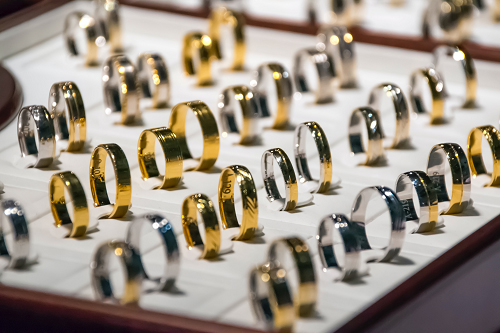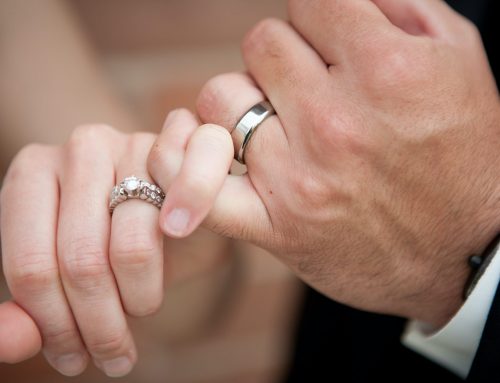Finding your ring size at home is actually a relatively easy task. In fact, if you have the actual ring at hand, you don’t necessarily need to know your ring size in order to test whether it fits or not. Generally speaking, a ring should not slide around your finger and should meet some resistance to removal at your knuckle, but it should not be difficult to remove.
Ring sizes range from 3 to 13.5 for adults, with 5 to 7 being typical for women, and 8 to 10 being typical for men. The “standard” sizes that you will most commonly find on display are 7 for women and 10 for men. It is also important to note that not all companies will offer rings in every size. Many omit half-sizes or only carry a limited range of common sizes.

Ring Size Chart
The following table can be used as a quick-reference for finding the correct ring size based on your finger measurement. Once you have measured the circumference of your finger, you can quickly convert that to industry-standard sizes to get the best fit ring — or have a ring resized as needed.
| Inside | Inside | Inside | Inside | Number Sizes | Wheat Sheaf |
||
| Diameter | Diameter | Circumference | Circumference | US/Canada | British | Japanese | Swiss |
| (inches) | (mm) | (inches) | (mm) | Standard | Irish | Equivalent | Equivalent |
|
|
Australian | ||||||
| Equivalent | |||||||
| 0.458 | 11.6 | 1.438 | 36.5 | 0 | |||
| 0.466 | 11.8 | 1.463 | 37.2 | 1/4 | |||
| 0.474 | 12.0 | 1.488 | 37.8 | 1/2 | A | ||
| 0.482 | 12.2 | 1.513 | 38.4 | 3/4 | A 1/2 | ||
| 0.490 | 12.4 | 1.539 | 39.1 | 1 | B | 1 | |
| 0.498 | 12.6 | 1.564 | 39.7 | 1 1/4 | B 1/2 | ||
| 0.506 | 12.9 | 1.589 | 40.4 | 1 1/2 | C | ||
| 0.514 | 13.1 | 1.614 | 41.0 | 1 3/4 | C 1/2 | ||
| 0.522 | 13.3 | 1.639 | 41.6 | 2 | D | 2 | 1.50 |
| 0.530 | 13.5 | 1.664 | 42.3 | 2 1/4 | D 1/2 | ||
| 0.538 | 13.7 | 1.689 | 42.9 | 2 1/2 | E | 3 | 2.75 |
| 0.546 | 13.9 | 1.714 | 43.5 | 2 3/4 | E 1/2 | ||
| 0.554 | 14.1 | 1.740 | 44.2 | 3 | F | 4 | 4.00 |
| 0.562 | 14.3 | 1.765 | 44.8 | 3 1/4 | F 1/2 | 5 | 5.25 |
| 0.570 | 14.5 | 1.790 | 45.5 | 3 1/2 | G | ||
| 0.578 | 14.7 | 1.815 | 46.1 | 3 3/4 | G 1/2 | 6 | 6.50 |
| 0.586 | 14.9 | 1.840 | 46.7 | 4 | H | 7 | |
| 0.594 | 15.1 | 1.865 | 47.4 | 4 1/4 | H 1/2 | 7.75 | |
| 0.602 | 15.3 | 1.890 | 48.0 | 4 1/2 | I | 8 | |
| 0.610 | 15.5 | 1.915 | 48.7 | 4 3/4 | J | 9.00 | |
| 0.618 | 15.7 | 1.941 | 49.3 | 5 | J 1/2 | 9 | |
| 0.626 | 15.9 | 1.966 | 49.9 | 5 1/4 | K | 10.00 | |
| 0.634 | 16.1 | 1.991 | 50.6 | 5 1/2 | K 1/2 | 10 | |
| 0.642 | 16.3 | 2.016 | 51.2 | 5 3/4 | L | 11.75 | |
| 0.650 | 16.5 | 2.041 | 51.8 | 6 | L 1/2 | 11 | 12.75 |
| 0.658 | 16.7 | 2.066 | 52.5 | 6 1/4 | M | 12 | |
| 0.666 | 16.9 | 2.091 | 53.1 | 6 1/2 | M 1/2 | 13 | 14.00 |
| 0.674 | 17.1 | 2.116 | 53.8 | 6 3/4 | N | ||
| 0.682 | 17.3 | 2.141 | 54.4 | 7 | N 1/2 | 14 | 15.25 |
| 0.690 | 17.5 | 2.167 | 55.0 | 7 1/4 | O | ||
| 0.698 | 17.7 | 2.192 | 55.7 | 7 1/2 | O 1/2 | 15 | 16.50 |
| 0.706 | 17.9 | 2.217 | 56.3 | 7 3/4 | P | ||
| 0.714 | 18.1 | 2.242 | 56.9 | 8 | P 1/2 | 16 | 17.75 |
| 0.722 | 18.3 | 2.267 | 57.6 | 8 1/4 | Q | ||
| 0.730 | 18.5 | 2.292 | 58.2 | 8 1/2 | Q 1/2 | 17 | |
| 0.738 | 18.7 | 2.317 | 58.9 | 8 3/4 | R | 19 | |
| 0.746 | 18.9 | 2.342 | 59.5 | 9 | R 1/2 | 18 | |
| 0.754 | 19.2 | 2.368 | 60.1 | 9 1/4 | S | 20.25 | |
| 0.762 | 19.4 | 2.393 | 60.8 | 9 1/2 | S 1/2 | 19 | |
| 0.770 | 19.6 | 2.418 | 61.4 | 9 3/4 | T | 21.5 | |
| 0.778 | 19.8 | 2.443 | 62.1 | 10 | T 1/2 | 20 | |
| 0.786 | 20.0 | 2.468 | 62.7 | 10 1/4 | U | 21 | |
| 0.794 | 20.2 | 2.493 | 63.3 | 10 1/2 | U 1/2 | 22 | 22.75 |
| 0.802 | 20.4 | 2.518 | 64.0 | 10 3/4 | V | ||
| 0.810 | 20.6 | 2.543 | 64.6 | 11 | V 1/2 | 23 | |
| 0.818 | 20.8 | 2.569 | 65.2 | 11 1/4 | W | 25 | |
| 0.826 | 21.0 | 2.594 | 65.9 | 11 1/2 | W 1/2 | 24 | |
| 0.834 | 21.2 | 2.619 | 66.5 | 11 3/4 | X | ||
| 0.842 | 21.4 | 2.644 | 67.2 | 12 | X 1/2 | 25 | 27.50 |
| 0.850 | 21.6 | 2.669 | 67.8 | 12 1/4 | Y | ||
| 0.858 | 21.8 | 2.694 | 68.4 | 12 1/2 | Z | 26 | 28.75 |
| 0.866 | 22.0 | 2.719 | 69.1 | 12 3/4 | Z 1/2 | ||
| 0.874 | 22.2 | 2.744 | 69.7 | 13 | 27 | ||
| 0.882 | 22.4 | 2.769 | 70.3 | 13 1/4 | Z1 | ||
| 0.890 | 22.6 | 2.795 | 71.0 | 13 1/2 | |||
| 0.898 | 22.8 | 2.820 | 71.6 | 13 3/4 | Z2 | ||
| 0.906 | 23.0 | 2.845 | 72.3 | 14 | Z3 | ||
| 0.914 | 23.2 | 2.870 | 72.9 | 14 1/4 | |||
| 0.922 | 23.4 | 2.895 | 73.5 | 14 1/2 | Z4 | ||
| 0.930 | 23.6 | 2.920 | 74.2 | 14 3/4 | |||
| 0.938 | 23.8 | 2.945 | 74.8 | 15 | |||
| 0.946 | 24.0 | 2.970 | 75.4 | 15 1/4 | |||
| 0.954 | 24.2 | 2.996 | 76.1 | 15 1/2 | |||
| 0.962 | 24.4 | 3.021 | 76.7 | 15 3/4 | |||
| 0.970 | 24.6 | 3.046 | 77.4 | 16 |
How to Measure Ring Size
There are three major options for finding your ring size on your own: using a ring you already have, using string or floss, or using a ring measurement tool.
Use a Ring You Already Have
If you already have a ring that fits well, you can use a ring size chart in order to determine what size it is — some of these charts are even printable. This is also a great option for gifts or wedding bands, as comparing existing rings may help you to maintain discretion.
Use String or Floss
For this method you will need:
- String or floss;
- A marker or pen;
- A ruler.
Tie string or floss tightly below the knuckle around the finger that you intend to wear the ring on. Mark both sides of the string where they meet on your finger. Remove the string or floss and measure the distance between the markings (if you do not have a ruler at hand, there are rulers available online to print). Record this measurement (the circumference of your finger) and consult/cross-reference the ring size chart above to find your ring size.
Tips for Ring Measurement
Here are a few factors you should take into consideration when finding your ring size:
- Variables unique to you, such as pregnancy, level of physical activity, or even the climate in which you reside can affect how a ring fits.
- A Hot weather can make your fingers swell, while cold weather can make them shrink.
- If you have particularly large knuckles (to the point that it makes rings difficult to remove), add a half size to your ring measurement.
- Thinner bands may sit more loosely on your finger, while thicker bands may be more difficult to remove.
- Your ring size may change as you age, due to things like changes in weight or knuckle swelling. Therefore, you should have your rings regularly resized.
- The use of hard metals such as tungsten carbide can prevent damage to a ring, but can also make resizing more difficult; hard metals are a good option for the sake of durability, as long as you don’t expect personal changes that will require resizing.
Resizing a Ring
As previously stated, it is a good idea to regularly check your ring size and resize as necessary. Generally speaking, rings can only be resized a few times due to the constitution of a ring’s structure; however, this depends on the style of the ring and the materials used. Some rings may not be able to be resized at all. Softer metals like gold will be easier to reform, but are also more prone to damage compared to rings made of tungsten or similar, hard metals. Any gemstones set in the ring are also an important variable to consider when resizing, as the application of heat may damage certain gemstones, and resizing of the ring may require resetting of the stones.
It is easier to make a ring smaller than it is to make a ring larger. To make a ring smaller, the jeweler will simply remove a portion of the band, and then solder it back together. Meanwhile, to make a ring bigger, the jeweler has to heat and stretch the ring or add a bridge to the band.
If you have any further concerns about a particular ring, it will be best to contact the seller.





Leave A Comment